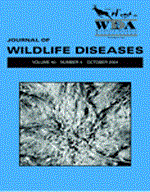Ranavirus (family Iridoviridae) is a genus of pathogens of poikilotherms, and some ranaviruses may play a role in widespread mortality of amphibians. Ecology of viral transmission in amphibians is poorly known but can be addressed through experimentation in the laboratory. In this study, we use the Ranavirus frog virus 3 (FV3) as an experimental model for pathogen emergence in naïve populations of tadpoles. We simulated emerging disease by exposing tadpoles of the Italian agile frog (Rana latastei), to the North American Ranavirus FV3. We demonstrated that mortality occurred due to viral exposure, exposure of tadpoles to decreasing concentrations of FV3 in the laboratory produced dose-dependent survival rates, and cannibalism of virus-carrying carcasses increased mortality due to FV3. These experiments suggest the potential for ecological mechanisms to affect the level of exposure of tadpoles to Ranavirus and to impact transmission of viral pathogens in aquatic systems.
How to translate text using browser tools
1 October 2004
RESPONSE OF THE ITALIAN AGILE FROG (RANA LATASTEI) TO A RANAVIRUS, FROG VIRUS 3: A MODEL FOR VIRAL EMERGENCE IN NAÏVE POPULATIONS
Peter B. Pearman,
Trenton W. J. Garner,
Monika Straub,
Urs F. Greber

Journal of Wildlife Diseases
Vol. 40 • No. 4
October 2004
Vol. 40 • No. 4
October 2004
amphibian decline
cannibalism
emerging diseases
Frog virus 3
iridovirus
IUCN Red List
Rana latastei




